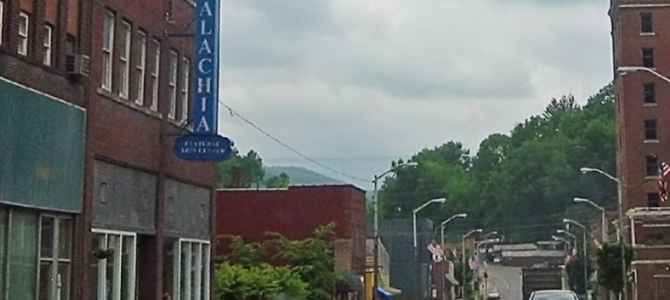
My favorite childhood memory goes something like this: It’s mid-afternoon on a summer day, and I am with my mamaw on her front porch in Letcher County, Kentucky. The sun has dropped behind the ridges that rise up on all sides.
We are surrounded by grocery bags filled with half-runner beans from the garden, a subsistence plot that has kept generations of men, women, and children alive. We are breaking and stringing beans in huge heaps, and she is telling me the “grown-up” gossip. Sometimes she sings folk songs. A life of hard work and hardship has made her hands drawn and painful, but Leora Branham still sings while she works.
Leading up to and following Donald Trump’s election in 2016, there has been a glut of mainstream cultural analysis about rural Appalachia and its people, from J.D. Vance’s much-lauded “Hillbilly Elegy” to the Wall Street Journal’s feature about the residents of Buchanan County, Virginia: “Donald Trump is Still Their Man.” As a native of rural Appalachia, I’ve read each piece of writing with faint amusement and hope that the spike in visibility will turn the tide of ignorance, bigotry, and outright cruelty with which Appalachian people are often met. What I’ve seen instead is, at best, a misunderstanding and, at worst, a misrepresentation of a culture that is undoubtedly in crisis.
Take, for instance, an article that appeared in Saturday’s New York Times called “In Coal Country, The Mines Shut Down, The Women Went to Work, and the World Quietly Changed.” Its premise is that the immediate answer to the collapse of the coal industry and the looming economic crisis is a cultural shift that allows women to enter the workforce.
According, presumably, to U.S. census estimates (the article doesn’t include a citation), Letcher County, Kentucky, saw “the greater [sic] shift of gender balance of its labor force than almost any other county in the United States” from 2010 to 2017. As further evidence that women at work represent a sea change in coal country, the author offers quotes from two men who don’t seem too sure about their breadwinning wives.
What’s truly strange about the article is not that it omits relevant economic statistics — for instance, that Letcher County is hemorrhaging not only jobs but people (estimates say 10 percent of its population since 2010), that it has failed even now to recover from the Obama-era recession, and that recent estimates put its median individual income at $18,085 and its median household income at $30,293, well below the national average. It’s that it wrongly denies a reality of Appalachian culture: women have always held the center.
In Appalachia, Women Make Sure the Work Gets Done
Appalachian culture has not decried female participation in the workforce; it has demanded it. The politics of survival don’t leave much room for debate.
A 1979 book called “Appalachian Women: A Learning-Teaching Guide” commissioned by the U.S. Department of Health, Education and Welfare under the Women’s Educational Act says pragmatism is what matters for division of labor in Appalachia. What’s important is not who does the task, it’s that the task is done.
An exhibit at southwestern Virginia’s William King Museum of Art in early 2018 featured a poem by outsider artist Fred C. Carter called “Ode to an Appalachian Mother.” It includes the following:
Your earth wisdom, your toil and love gave us our food, clothing, and shelter. Wise in the way of TIME, you endured fire, ice, joy and agony, working always, tending us ever.
These depictions of Appalachian women aren’t theoretical. In the late-1950s and ’60s during a coal slump, my papaw Oxur Branham left Kentucky to find construction work in booming Washington, D.C. Mamaw cleaned houses, canned food, ran a gypsy cab service, made clothes and quilts, worked as a cashier, and managed a local skating rink.
During one particularly grisly assignment, she was enlisted to help clean up in the aftermath of a violent suicide. These tasks, of course, were performed in addition to her duties as a subsistence farmer, cook, and mother to five children.
Politicians Prove They Are Clueless About Appalachia
In attitudes about women, coal country has not changed as the New York Times suggests. Nor has the stereotypical and derogatory coverage in popular and political culture (think “Deliverance”). What has changed is the desired political outcome.
In 2016, Trump dominated the Appalachian vote, and — in leftist circles — a much-touted reason for his success was regression and backwardness in Appalachian viewpoints. The jobless, hopeless, and drug-addicted men in the coalfields, they said, did not want women and minorities to succeed as progressives did.
Hillary Clinton was among the scoffers. In a 2018 speech in Mumbai, India, she mockingly addressed Trump voters: “You know you didn’t like black people getting rights. You didn’t like women, you know, getting jobs. You don’t want to, you know, see Indian Americans succeeding more than you are.”
What politicos on both sides of the aisle have refused to acknowledge is that complexity, creativity, and determination are the hallmark of the Appalachian people. Acknowledging that Appalachia, or what remains of it, is not altogether backward and unenlightened might mean embracing the task of finding real solutions to real problems — problems due in no small part to the systematic failure of political institutions. It would mean that Washington would have to look inward for root causes, and the federal city abhors self-reflection.
Meanwhile, Appalachia is here quietly waiting for the world to change.









